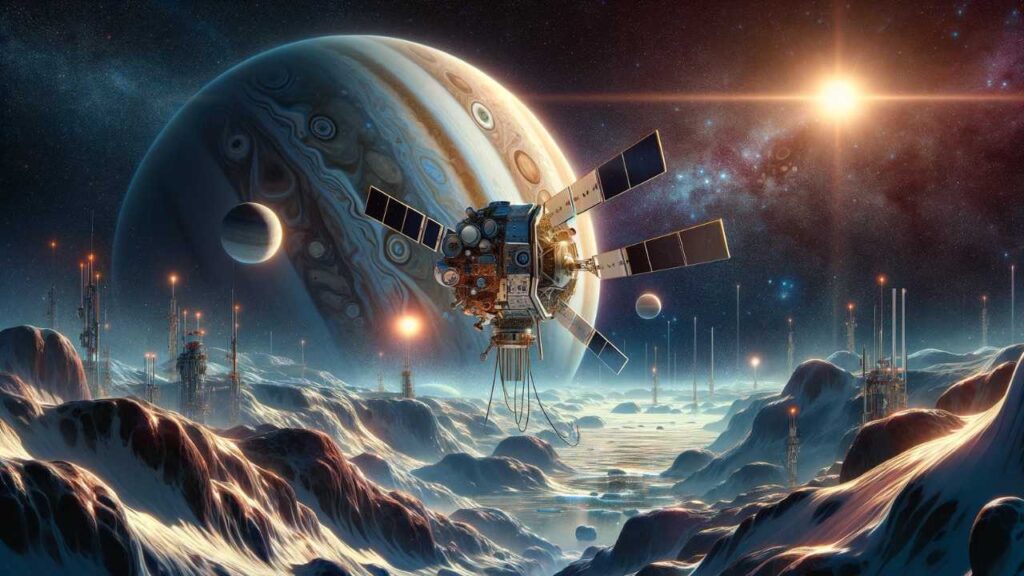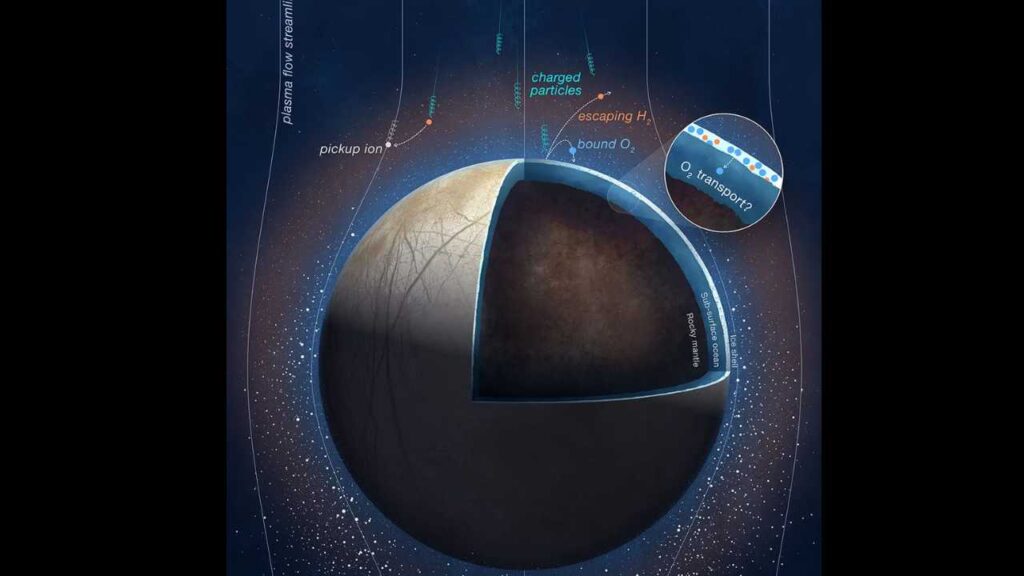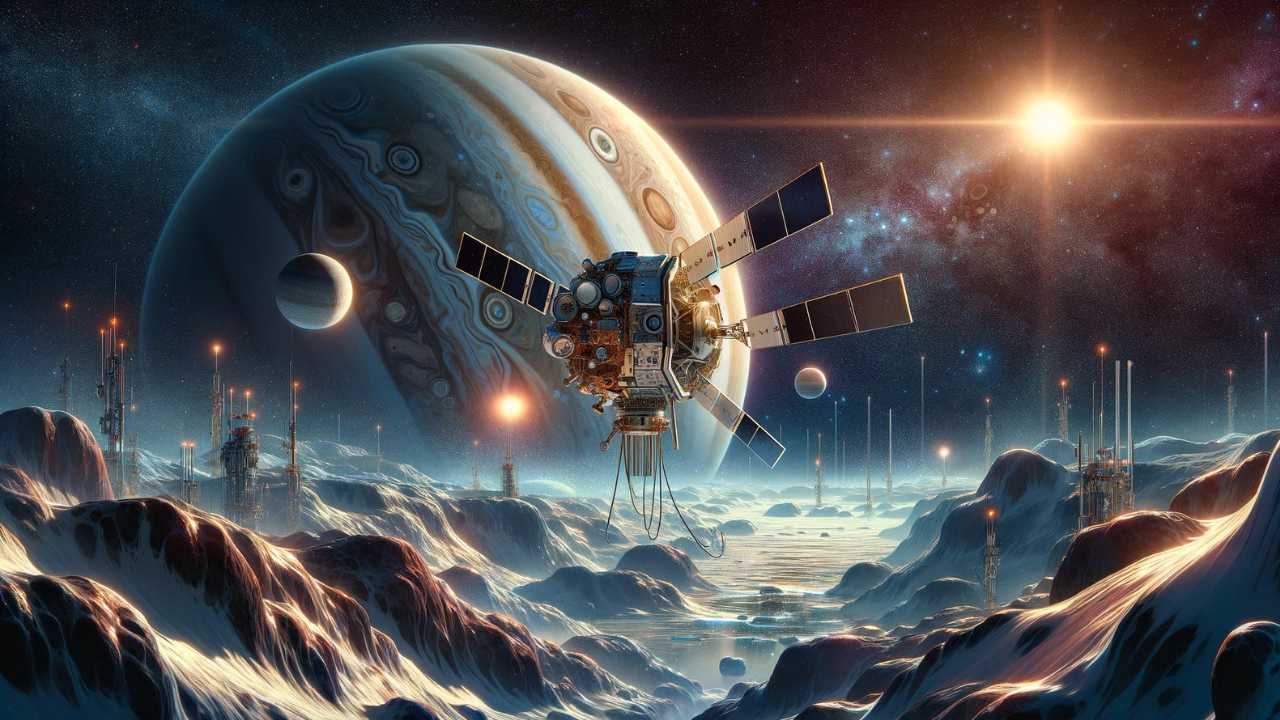“NASA, Juno Mission, Europa Oxygen Production, Jupiter’s Moons, Space Exploration, Astrobiology, Extraterrestrial Life, Solar System, Icy Moons, Europa Habitability, Space Missions, Jovian System, Europa Clipper, Scientific Discoveries, Outer Space Research”
“Discover the groundbreaking findings from NASA’s Juno Mission about Europa’s oxygen production. Explore how these revelations alter our understanding of Jupiter’s moon, the potential for extraterrestrial life, and the future of space exploration. Dive into the scientific journey of unlocking the mysteries of the solar system’s icy worlds.”

In a groundbreaking study that is reshaping our understanding of the outer solar system, NASA’s Juno mission has unveiled surprising findings about oxygen production on Europa, one of Jupiter’s most intriguing moons. This revelation not only deepens our knowledge of the Jovian system but also sparks new questions about the potential for life beyond Earth.
Juno’s Journey to Jupiter
Launched on August 5, 2011, the Juno spacecraft embarked on a daring mission to Jupiter, aiming to uncover the hidden secrets of the gas giant and its moons. Equipped with state-of-the-art scientific instruments, Juno has been scrutinizing Jupiter’s atmosphere, magnetic fields, and auroras, offering unprecedented insights into the planet and its environment.
Groundbreaking Findings on Europa
Europa, the icy moon of Jupiter, has long captivated scientists with its potential to host extraterrestrial life. Beneath its frozen surface lies a vast ocean of liquid water, a crucial ingredient for life as we know it. Juno’s recent measurements, conducted by the Jovian Auroral Distributions Experiment (JADE), have revealed that oxygen production on Europa is significantly lower than previously thought, at about 26 pounds (12 kilograms) per second. This discovery challenges earlier estimates and provides vital clues to understanding Europa’s complex ecosystem.
The Importance of Oxygen Production
Oxygen is a critical component for the potential habitability of Europa’s subsurface ocean. The process of generating oxygen through the splitting of water molecules by charged particles from Jupiter could offer a source of metabolic energy for life forms. Juno’s findings not only refine our estimates of oxygen availability but also highlight the dynamic processes at play on Europa’s icy surface and the moon’s interaction with its parent planet.
Advanced Technology Unveiling Cosmic Mysteries
Juno’s mission is powered by cutting-edge technology, including a suite of 11 scientific instruments designed to study Jupiter’s magnetosphere, atmosphere, and satellite interactions. These tools have allowed scientists to capture and analyze data on Europa’s oxygen production, shedding light on the moon’s environment and its potential to support life.
Looking Ahead: The Future of Jovian Exploration
The implications of Juno’s findings are far-reaching, setting the stage for future missions to Europa, such as the highly anticipated Europa Clipper mission scheduled for launch in the 2020s. By investigating Europa’s ice shell, subsurface ocean, and potential habitability in greater detail, scientists hope to answer fundamental questions about life beyond Earth.
NASA’s Juno mission has once again demonstrated the power of human curiosity and ingenuity in uncovering the mysteries of the cosmos. As we continue to explore Jupiter and its moons, each discovery brings us one step closer to understanding our place in the universe. The insights gained from studying Europa’s oxygen production are not just scientific achievements but also beacons of hope for unraveling the secrets of life beyond our planet.
As the Juno mission continues to deliver critical data about the Jovian system, the world eagerly awaits the next chapter in our cosmic journey, inspired by the boundless possibilities of space exploration and the enduring quest for knowledge.

NASA’s Juno mission
NASA’s Juno mission, orbiting Jupiter since July 2016, has revolutionized our understanding of the giant planet and its moons. The mission’s recent findings on Europa, one of Jupiter’s largest moons, have particularly captured the scientific community’s attention. These discoveries not only provide new insights into the moon’s environment but also have significant implications for the search for life in our solar system and beyond.
Europa’s Oxygen Production: A Closer Look
While Juno’s detection of lower-than-expected oxygen production on Europa is a pivotal discovery, the mechanisms behind this phenomenon offer a fascinating puzzle. The process, driven by the bombardment of Europa’s ice by magnetospheric particles from Jupiter, prompts a reevaluation of our models of chemical interactions on icy moons. Understanding the nuances of this oxygen generation process could reveal much about Europa’s geophysical processes and its ability to support life.
The Role of Europa’s Unique Environment
Europa’s position within Jupiter’s magnetic field exposes it to intense radiation, affecting its surface and potentially its subsurface ocean. This harsh radiation environment could play a dual role, both enabling the breakdown of water into oxygen and hydrogen and potentially threatening the stability of complex organic molecules. The balance between these processes is crucial for assessing Europa’s habitability and the survival of potential biosignatures.
Technological Breakthroughs and Methodological Advances
Juno’s achievements are not just due to its sophisticated suite of instruments but also to the innovative methodologies applied in analyzing the data. For instance, the use of JADE to measure the outgassing of hydrogen and derive oxygen production rates showcases the power of indirect observation techniques in space exploration. Such approaches are expanding our capabilities for exploring and understanding bodies within our solar system that are not easily accessible.
Implications for Astrobiology and the Search for Extraterrestrial Life
The revised estimates of oxygen production on Europa have profound implications for astrobiology. Oxygen is a key ingredient for life as we know it, and its presence in Europa’s ocean could influence the types of organisms that might survive there. The findings from Juno thus contribute to a larger discussion on the diversity of life-supporting environments that might exist beyond Earth.
Future Missions Inspired by Juno’s Discoveries
Building on Juno’s discoveries, future missions to Europa and other icy moons, such as Saturn’s Enceladus, are being planned with enhanced objectives. The Europa Clipper mission, equipped with more advanced instruments for in-depth analysis of Europa’s surface and subsurface ocean, aims to build on Juno’s legacy. These missions hope to further unravel the mysteries of the solar system’s icy worlds, with an eye towards discovering signs of past or present life.
Collaborative International Efforts and the Future of Space Exploration
The success of Juno and the anticipation surrounding future missions underscore the importance of international collaboration in space exploration. With contributions from the European Space Agency (ESA), the Italian Space Agency (ASI), and other partners, missions like Juno exemplify how collaborative efforts can lead to groundbreaking scientific achievements. As we continue to explore the unknown, such partnerships will be crucial in advancing our understanding of the universe.
Conclusion: A Gateway to Cosmic Discoveries
The Juno mission’s insights into Europa’s oxygen production mark a significant milestone in our exploration of the Jovian system. These discoveries not only enhance our knowledge of Europa but also set the stage for future explorations that could redefine our understanding of where and how life might exist in the cosmos. As we stand on the brink of these potential discoveries, the contributions of Juno to space science and our quest for understanding life’s universal conditions will undoubtedly be remembered as a pivotal chapter in the history of space exploration.
Other Links-
- SpaceX-NASA Crew 8 Mission
- Nasa private Odysseus
- NASA Rover Captures Image of Solar Eclipse On Mars, See Photos
- Revolutionizing Space Communication










